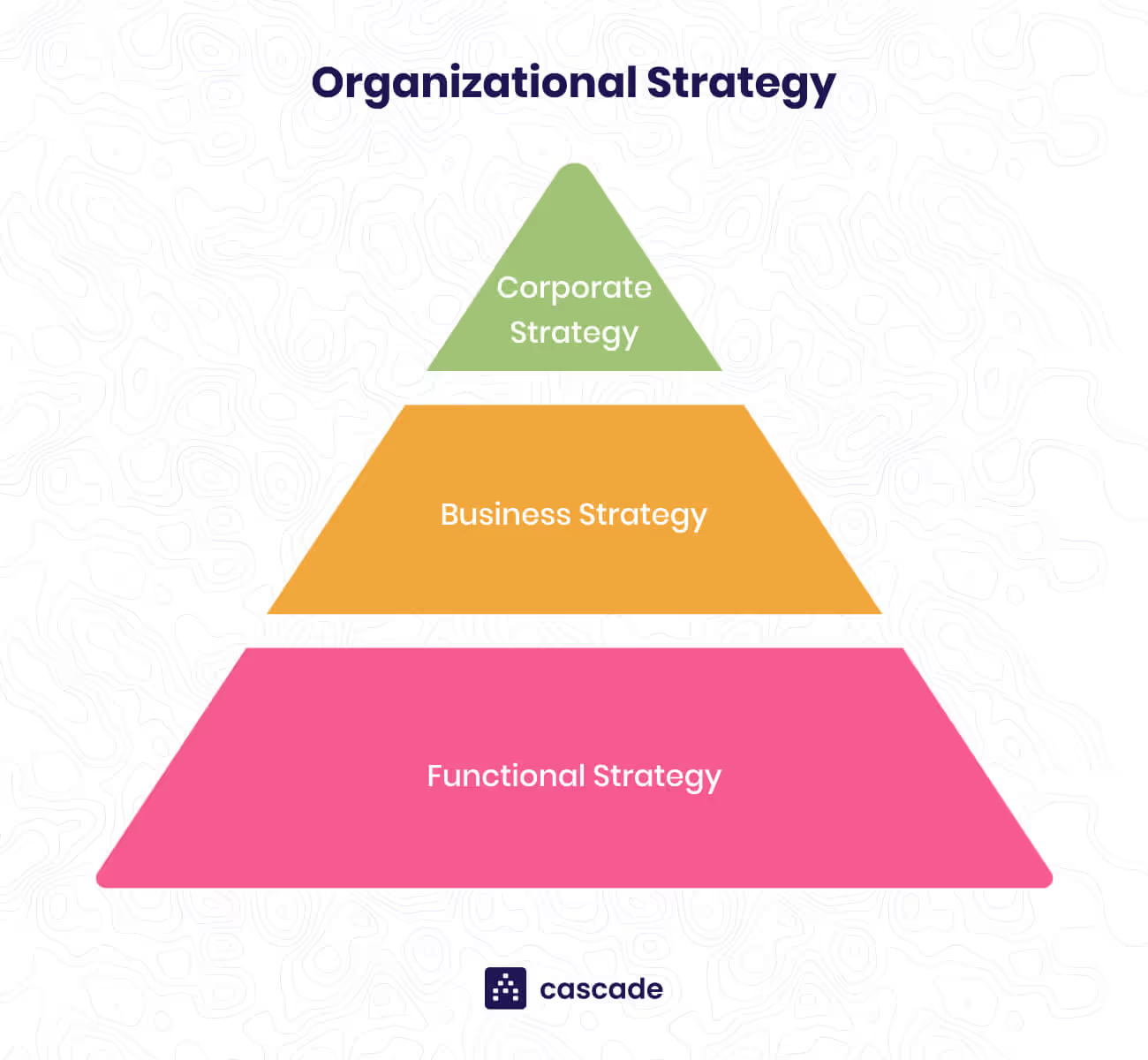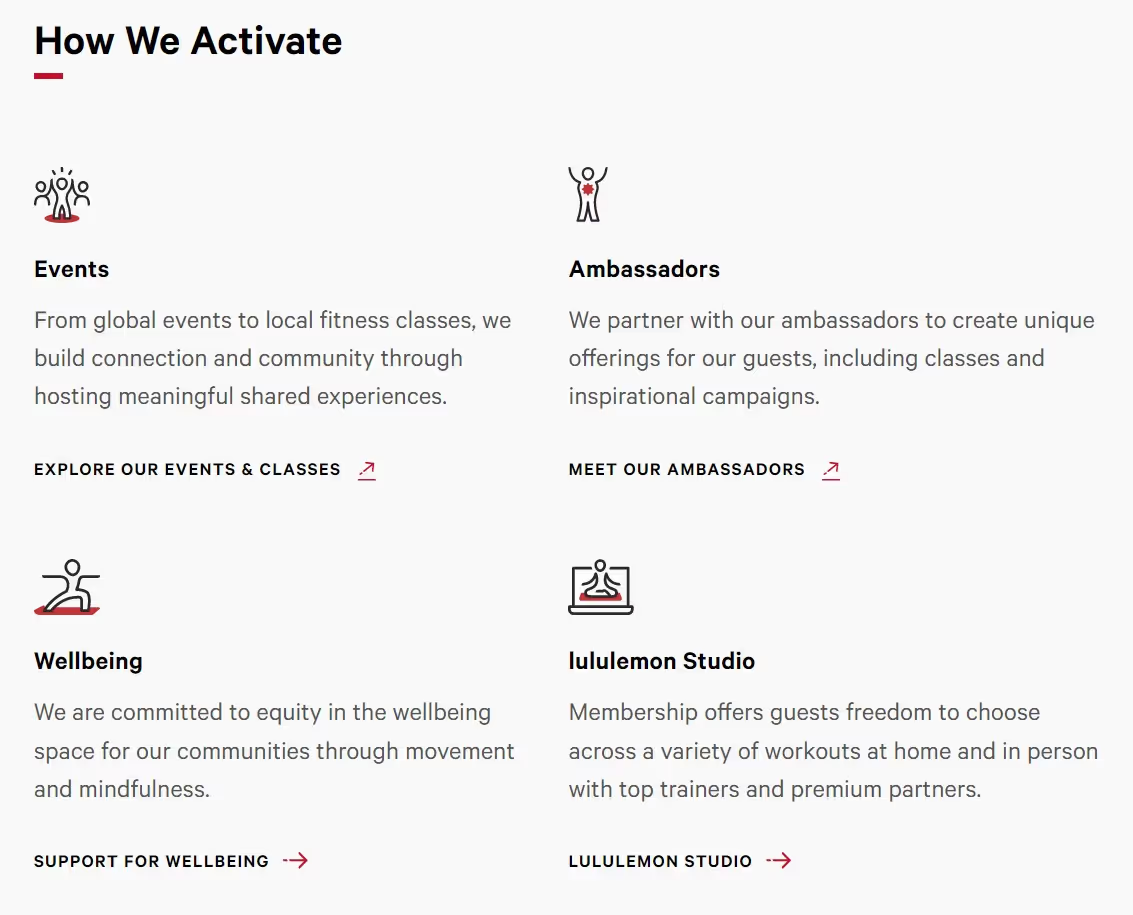Take a moment to ponder on this piece of advice from Charlie Munger, the vice chairman of Berkshire Hathaway, who successfully steered one of the biggest companies in the world for over 40 years. He said:
"Our job is to find a few intelligent things to do, not to keep up with every damn thing in the world."
So, what's the smartest thing you can do for your business? Our answer: Build a strong organizational strategy that can adapt to changes.
In this article, we'll break down what organizational strategy is, how it works, and why it's important for your business. We'll also guide you through the key elements, provide you with helpful tools to get started, and share real-life examples from other businesses.
In this article, you’ll discover:
- What Is Organizational Strategy?
- 3 Levels Of Organizational Strategies
- Benefits Of A Strong Organizational Strategy
- Key Elements Of An Effective Organizational Strategy
- Best Practices For Implementing Your Organizational Strategy
- Organizational Strategies Examples
- Execute Your Organizational Strategy With Cascade
What Is An Organizational Strategy?
Organizational strategy is a set of strategic choices that guide your company's approach toward achieving its long-term goals. This strategy should combine your strategic planning efforts across your organization and act as the building blocks for future growth.
An organizational strategy should help business leaders:
- Define goals and objectives: Set clear and quantifiable targets that align with your company's long-term focus.
- Prioritize projects, goals, and initiatives: Concentrate on the most critical issues by establishing priorities that align with your business's strategic vision.
- Allocate resources: Efficiently distribute resources to support strategic initiatives, ensuring they have the necessary backing to succeed.
- Review and adapt their approach: Regularly evaluate and adjust the strategic plan in response to changing circumstances, ensuring your strategy remains adaptable and relevant.
3 Levels Of Organizational Strategies
If you ask different people in your company about the organization’s strategy, you’ll probably get a different answer each time.
And they wouldn’t be wrong. The organizational strategy comprises various strategy levels, each honing in on a distinct facet or perspective of the comprehensive business strategy.

Corporate level strategy
Corporate level strategy is the highest overarching strategy within an organization which guides the company's overall direction toward long-term objectives.
At a corporate level, the strategy focuses on three imperatives:
- Growth: Establishing ambitious yet attainable objectives for company-wide expansion.
- Stability: Maintaining the company's position or market share.
- Change: Planning for organizational change or transformation to navigate the complex business landscape or seize new opportunities.
Business level strategy
One level down, the business level strategy is where broad corporate strategies are translated into more concrete, market-focused strategies. This strategy level is about making strategic choices concerning individual business units or divisions within the broader corporate structure.
A business strategy will usually cover broader aspects of the business, such as:
- Product or service differentiation: This involves identifying the unique aspects of the products or services to focus on within individual business units, setting them apart from competitors.
- Customer Segments: For example, identifying prospective customer groups, and considering their distinct needs and preferences.
- Sales Channels: For example, determining how new products and services will be marketed and distributed to reach your target audience.
- Competitive Advantage: Strategizing to maximize unique strengths and capabilities within the business unit that enable it to outperform its direct competitors, whether that's through superior service, product quality, innovative technology, or other factors.
📚Recommended read: 6 Competitive Analysis Frameworks: How to Leave Your Competition In the Dust
Functional level strategy
At the base of the strategic pyramid, the functional level strategy focuses on the efficient execution of business level strategy through various organizational functions such as IT, marketing, sales, and finance.
For example, a functional strategy would be concerned with:
- Prioritizing functions: Identifying critical functions and business activities that contribute most to achieving business-level goals and allocating resources accordingly.
- Streamlining activities: Ensuring organizational activities in each function align with, and efficiently contribute to, the business and corporate-level strategies.
- Managing Performance: Establishing Key Performance Indicators (KPIs) to track, monitor, and improve the effectiveness of each function in meeting its designated objectives.
💡Corporate strategies outline the overall strategic vision, business strategies translate that vision into competitive actions within specific markets, and functional strategies operationalize these actions within the organizational departments.
Benefits Of A Strong Organizational Strategy
A strong organizational strategy is critical to businesses focused on long-term sustainable growth and success. But, if you’re new to the concept, here are some key reasons why you should start making organizational strategy a priority now.
Increased focus
An organizational strategy keeps your teams focused on the company’s goals and outcomes at every business level. By minimizing distractions and prioritizing what matters most, you can streamline your business processes, allocate resources more effectively, and achieve better results.
Better decision-making
The organizational strategy provides a framework for evaluating options, reducing uncertainty, and taking decisive actions that align with your business plan.
Full visibility into all key elements of your organizational strategy, including progress and setbacks on key strategic initiatives and projects, is crucial to effective decision-making and prioritization.
It starts with having all business data in one place, so you can monitor what's working and what's not in real time.
Improved alignment
When your organizational strategy is clear, it's easier to ensure that all aspects of your business—from daily operations to long-term goals—are aligned.
This ensures everyone works toward a common goal and allows people to innovate, build, and grow the business.
Faster business growth
Lastly, a well-developed organizational strategy propels business growth by providing a roadmap for expansion and scaling.
You can increase your market share, revenue, and profitability by identifying growth strategies and laying the groundwork for future opportunities. This approach enables you to adapt with agility and capitalize on new developments in your industry.
Key Elements of an Effective Organizational Strategy
Here are some key elements that any successful organizational strategy should have:
🎯 Focus areas
Focus areas are specific parts of your business that need attention. Identifying focus areas helps ensure efforts align with your long-term vision. This alignment improves efficiency, enhances team cohesion, and accelerates progress toward strategic goals.
📌 Objectives
Strategic objectives are concrete outcomes your company aims to achieve. Your organization’s strategy should set clear, measurable objectives and targets to provide direction, focus activities, and offer a means of measuring progress.
🔭 Projects and actions
These are specific steps or action plans designed to meet objectives. Your organizational strategy must provide a clear roadmap for achieving objectives by incorporating specific steps, resources, timelines, budgets, and responsibilities.
📐 KPIs
KPIs are measurable values that track progress toward objectives. A robust organizational strategy should enable continuous performance tracking, facilitate decision-making, and help teams adjust strategies as needed.
👑 Owners
Owners are individuals or teams responsible for implementing specific objectives, projects, and action plans. A solid organizational strategy will outline clear ownership roles, foster accountability, and a results-oriented organizational culture.
🔧 Resource allocation
An organizational strategy should help determine the resources required for each initiative and project, including capital, human resources, and technology. Strategic allocation of these resources can help maintain balance among various priorities and ensure objective achievement.
👉 Here's how Cascade can help you:
Looking to kickstart your strategy? We've got just the thing for you. Our library of pre-filled strategy templates is designed to help businesses, big and small, put strategy at the forefront.
Plus, you'll get access to powerful features, like robust data integrations, easy-to-use reporting tools, and impactful visualizations to propel your strategic planning and execution.
If you’re ready to simplify your strategic process and focus on what's vital for business growth, try the Organizational Strategy Template today.
✨More related templates:
- Corporate Strategy Plan
- Operational Plan Template
- Strategic Growth Plan Template
- Business Strategy Template
- Organizational Change Management Plan Template
Best Practices For Implementing Your Organizational Strategy
Implementing your organizational strategy effectively involves more than just having a comprehensive vision—it also requires leveraging the right tools and following best practices.
Centralize your data and analyze your performance
To make informed decisions, you should centralize all your organization's data. Cascade enables you to integrate with over 1000+ business tools, allowing you to import data from almost anywhere and create visual representations all in one place.
Make an impact with simple strategies
Focus on straightforward strategies that can deliver tangible results. Cascade's structured strategic planning helps you simplify the process, enabling you to effectively identify opportunities and align your organization's efforts.
Build alignment across your organization
Alignment is crucial to ensuring your organization is rowing in the direction and achieving outcomes that matter to the business. The power of Cascade is that it can unify every employee, team, and department under one strategy, connecting projects, goals, and metrics to a large-scale vision. This ensures alignment from top to bottom, bridging the gap between daily operations and your organization's future.
%20(1).png)
“With the ability to build multiple structured plans, we have been able to align, communicate and track the progress of our goals within and across departments in our organization.” - Peter W., Business Planning Manager, G2
Assign responsibilities and drive accountability
A clear understanding of roles and responsibilities not only fosters accountability but also promotes a results-oriented organizational culture. With Cascade, you can add users, assign goals, and work collaboratively with real-time updates, creating different plans for multiple teams.
Create a system for tracking progress and making adjustments
A dynamic strategic planning process should include tracking progress and adapting your strategy when needed. With Cascade, you can adjust plans on the fly and keep your teams on track even when circumstances change.
.png)
“I like how Cascade Strategy encapsulates both KPIs and projects in one platform. This is much easier than having a separate dashboard and project software. Additionally, Cascade links all KPIs and projects throughout the organization.” - Craig P., G2
Organizational Strategies Examples
Lululemon
Lululemon's organizational strategy is built on a foundation of quality and design, focusing on a niche market of yoga and fitness apparel for middle to upper-class women.
The company prioritized employee satisfaction and strong branding, creating a positive work environment and a brand image that resonates with its target audience.

Lululemon's commitment to exceptional customer experience, including personalized shopping and free yoga classes, along with the effective use of social media and a successful ambassador program, has allowed it to carve out a unique market niche and build a loyal customer base.
📚Read the full case study here.
Bumble
Bumble's organizational strategy is defined by its female-centric approach to online dating which offers women a safer and more comfortable environment.
The company has diversified its services beyond dating, introducing Bumble BFF for finding friends and Bumble Bizz for professional networking. Bumble's commitment to advocacy and activism, particularly around women's rights and safety, is reflected in its marketing strategies and innovative app features.

With precise brand positioning and a focus on user experience and engagement, Bumble has seen consistent growth in its user base. Most of its revenue is generated through subscription fees for premium features.
📚Read the full case study here.
Disney
Disney's organizational strategy is characterized by long-term clarity and innovation, with a willingness to take risks to achieve its vision.
The company has diversified and expanded its operations, moving into new industries and markets and creating a unified brand experience.

Disney has kept growing and remained relevant due to its focus on customer relationships and data use, along with its willingness to embrace disruptions — such as the launch of its streaming service, Disney+.
Prioritizing employee care and making strategic acquisitions, like Pixar and Marvel, have further contributed to Disney's position as a global leader in the entertainment industry.
📚Read the full case study here.
Execute Your Organizational Strategy With Cascade 🚀
If you’re looking for a competitive advantage and sustainable business growth, your business needs a solid organizational strategy. But creating one that will suit your needs can be challenging. That’s where Cascade, the #1 strategy execution platform, comes in.
Why? Because it’s more than just software. It's a comprehensive solution designed to house your strategy, planning, and execution all in one place.
It also has strategy-focused features to help you centralize all business data, visualize performance with strategy dashboards, and create comprehensive reports for your stakeholders.
Sign up today for free or book a 1:1 product tour with Cascade’s in-house strategy expert.
FAQs
What are the types of organizational strategies?
There are several types of organizational strategies that you can adopt, including a growth strategy, competitive strategy, diversification strategy, cost leadership strategy, market development strategy, and many more. Your chosen strategic approach will depend on your business goals and objectives.
What are the features of an effective organizational strategy?
The key features of an organizational strategy are:
- Specific: Clearly defined objectives.
- Measurable: Goals that can be quantified and evaluated.
- Realistic: Attainable within the organization's capabilities.
- Limited: Focused on key priorities.
- Adaptable: Flexible to changing circumstances.






.png)
.jpg)
.jpg)
%20(1)%20(1)%20(1)%20(1)%20(1).png)



